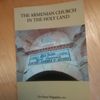Last week, I was invited to deliver a talk in Germany at the annual Synod of the European Diocese of the Church of England. The organisers offered me ninety generous minutes to cover the whole MENA and Gulf regions.
A challenging mandate, but one that I accepted with gusto. And whilst I believe that I gave the different hotspots - Tunisia, Egypt, Libya, Syria, Yemen the GCC - due diligence and ample analysis, I must also admit that I started and ended my talk with Palestine and its 59-year-old conflict (assuming that the chronometer starts running in 1967) that has become the longest and saddest story of occupation in modern history.
Why did I do that, one might reasonably query, given that the Arab Spring has been absent in the Palestinian territories and that the situation has been relatively quiescent? After all, some mischievous commentators might opine that the conflict is being managed quite well: after all, Israel is not truly being sanctioned by the world community and the Palestinians are not really starving like many Syrians or Yemenis today.
Quite true, but Palestine remains the granddaddy of all the conflicts in the Levant since before the British Mandate and the creation of the State of Israel. Buzz words like Nakba and Naksa or UNGAR 194 (on refugees) and UNSCR 224 or 338 (on the illegality of occupation) are part of the political lexicon of every Arab man or woman in the region. It is instinctive, nay intuitive, and therefore the Israel-Palestine conflict (with one predatory state and another virtual one) has been - and still abides - a central hub for Arabs and Muslims alike.
At its most reader-friendly level, the story of Palestine can be explored in Dr Ghada Al-Karmi's In Search of Fatima. However, Palestine is much more than a story that turned sour. It encapsulates elements of history, psychology and emotional investment. It highlights colonialism, betrayal and treachery. It is even not solely about an epic struggle against the injustice and inequity perpetrated against the original inhabitants of this parcel of land by a Western world guilt-ridden about the Holocaust. Perhaps it is about a formula that turned into a master-and-slave equation between increasingly arrogant Israelis and pliantly subjugated Palestinians!
Having worked on the second-track negotiations of the Israeli-Palestinian conflict during the [now much-maligned] Oslo years, and having also advised the traditional Churches of Jerusalem about the political process, I am well aware that the solution to the conflict is within reach. If one looks at the various UN Resolutions, the Clinton Parameters, Taba in 2001, the Arab Peace Initiative of 2002 (re-endorsed in 2007), the Olmert-Abbas talks of 2008, as well as other moots, all of them support the critical inevitability of a two-state solution. Otherwise put, the only credible solution is the emergence of two states - Israel and Palestine - existing as neighbours next to each other.
But a cynic would wonder why Israel should cede territory it controls to the Palestinians? With a turgid ideology that matches its concrete separation wall, it can try to perpetuate the occupation. Yet, failure to reach agreement would either lead to the dangerous chaos and more apartheid-style control by Israel that breeds more violence, mayhem and - why not - ISIL-style radicalisation. Or else it would augur a binational one-state solution that coerces Israeli Jews and Palestinian Arabs (Muslims and Christians) living in one state, altering the demographics of this land in favour of Palestinian Arabs and inevitably turning into a tinderbox that spews out more vitriol and violence.
However, the present successive right-wing governments led by PM Benyamin Netanyahu have continued a policy of dispossessing Palestinians of their lands through a relentless plan of encroaching settlements and outposts that have been no more than illegal land-grabs which have been conducted with sheer impunity and a total disregard to International law, its Geneva Conventions and even EU foreign policy objectives. Just take a look at a recent MSNBC TV presentation of the four maps showing the gradual loss of Palestinian land from 1946 till the present day via the UN Plan of 1947 and the subsequent colonisation by Israel of Palestinian lands. It should become evident to the most colour-blind pundits or double-speak politicians that we are heading for disaster.
The solution consists not of constantly colliding two narratives, but rather of giving rise to two states alongside the Green Line with appropriate swaps or adjustments and creative diplomatic solutions to the core issues of Jerusalem, refugees, security and water. Otherwise, and whether we invoke Sisyphean or Promethean analogies to this festering conflict, the result will only spell disaster that will continue to haunt us despite the uprisings in the MENA region.
And for those who refuse to wake up before it is too late, who are not too fretful about the human impact of the occupation on both victim and victimiser, or who are even lulled into a false sense of security or irredentist ideology, they should recall the experience of South Africa. Here was a country where one group had the power to rule over another and pen its native inhabitants into Bantustans. Yet, the inextinguishable human yearning for justice prevailed despite considerable odds until South Africa exited its nightmare. Ditto with Palestine too!
